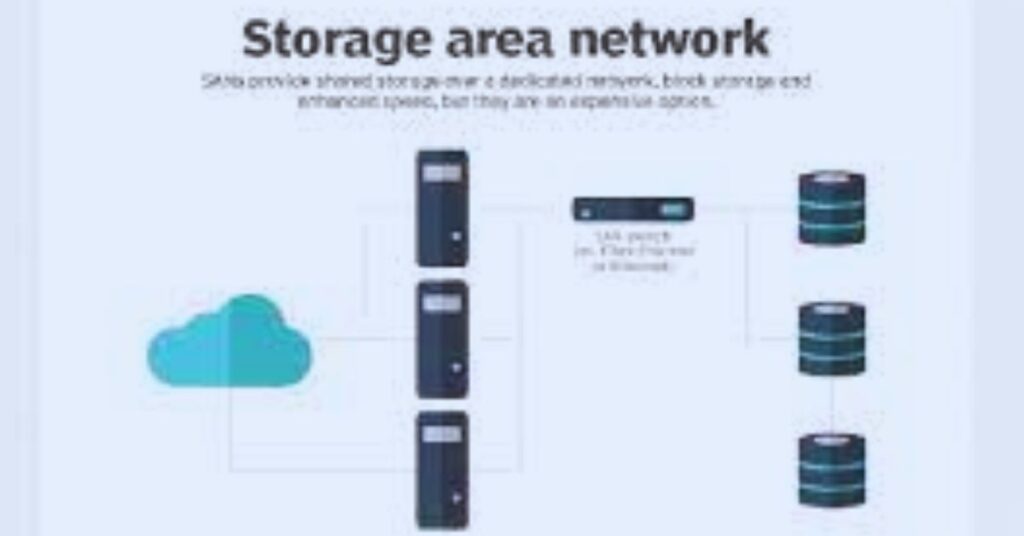A simple storage network (SAN) is a dedicated high-speed network that provides access to consolidated block-level data storage.
SANs are primarily used to enhance storage device accessibility for servers so that the devices appear to the operating system as locally attached drives.
Table of Contents
Definition of SAN
A SAN typically comprises storage devices like disk arrays, tape libraries, and optical drives that are connected to a dedicated storage network.
This network functions independently of the local area network (LAN) and uses a separate high-speed network technology like Fiber Channel. The key advantage of a SAN is that it enables sharing of storage resources efficiently among multiple servers. This leads to better asset utilization.
Components of a SAN
The main components that make up a simple SAN include:
- Servers – The servers connect to the storage devices on the SAN to access and retrieve data.
- Storage devices – Disk arrays, tape libraries, optical jukeboxes, etc. that provide the actual storage capacity.
- SAN fabric – The connecting network that provides the infrastructure for communication between servers and storage. Common fabrics include Fibre Channel and iSCSI.
- SAN switches – Switches and directors route data traffic between SAN devices.
- Cables and connectors – Fiber optic cables and adapters provide the physical connectivity.
- SAN management software – Provides the interface to configure, monitor, and manage the SAN fabric and storage allocation.
Advantages of SAN: Simple Storage Network
Some key benefits of deploying a SAN include:
- Scalability – SANs can scale out quickly and non-disruptively to meet storage growth needs.
- Utilization – Storage resources can be pooled and allocated dynamically leading to high utilization.
- Availability – Data continues to be available even if a storage device fails.
- Flexibility – Resources can be reallocated to servers easily without disruption.
- Distance – SANs enable remote data replication over large distances.
- Security – Centralized data and controlled access via zoning.
SAN Architecture and Topologies
There are two key architectural considerations when designing a SAN – the hardware components used, and the physical topology of connections.
SAN Components
A basic SAN architecture includes four core components:

Servers and Storage Devices
The servers connect to the SAN to access centralized storage. Typical storage devices include disk arrays, tape libraries, and optical jukeboxes.
Networking Infrastructure
The physical connectivity between servers and storage is enabled by SAN switches, directors, hubs, and cabling. Fiber Channel is the primary SAN networking technology.
SAN Management Software
This provides the interface to configure SAN resources, map storage to servers, and monitor and tune performance.
SAN Topologies
Two common SAN topologies include:
Fabric Topology
This utilizes Fibre Channel switches to provide dedicated connections between servers and storage. Common fabric topologies include:
Switched Fabric
Servers and storage connect to the same SAN switch. Easy to implement but limited scalability.
Direct Attached
One or more SAN switches are dedicated individually to servers and storage. Supports more devices.
Arbitrated Loop Topology
Servers and storage connect in a loop or ring, with each device in sequence. Low cost but limited scalability.
Implementing and Managing SANs
Deploying a new SAN involves planning, hardware setup, configuration, testing and ongoing administration.

SAN Implementation Steps
Key steps include:
- Design based on requirements and growth
- Procure hardware – servers, storage, switches, cables
- Install and configure SAN switches
- Connect cables between devices
- Allocate storage resources
- Map storage to servers
- Test connectivity and performance
SAN Management and Monitoring
Essential SAN monitoring and management tasks:
- Performance tuning and optimization
- Capacity monitoring and growth management
- Fault detection and recovery
- Resource allocation and provisioning
- Security administration and access control
SAN Security
Important security considerations for a SAN:
- Zoning to control server access to storage
- LUN masking to present authorized LUNs
- Access control for SAN management
- Encryption of data-in-transit
- Physical security of data center
The Future of SAN Technology
SAN technology continues to evolve with new standards and capabilities.

Emerging SAN Trends
- Increased adoption of all-flash storage
- Automation and artificial intelligence features
- Support for NVMe over Fabrics
- Shared storage for hyper-converged infrastructure
Challenges for Widespread SAN Adoption
- Perception as expensive and complex
- Scarcity of Fibre Channel skills
- Competition from other architectures like NAS
- Management across on-prem and cloud environments
Conclusion
SANs offer centralized, high-performance storage networking for modern data centers. As data demands grow, SANs provide scalable and resilient block storage access.
With sound design and proactive management, SANs can deliver robust and secure shared storage infrastructure. The future will see SANs becoming faster while integrating seamlessly into software-defined data centers.
FAQs
What are the main advantages of SAN storage?
The key advantages of SAN storage include centralized storage management, better disk utilization, scalability, high availability, and serviceability. SANs also provide data sharing, improved security, and disaster recovery capabilities.
What is the difference between SAN and NAS?
SAN provides block-level storage access over a high-speed network. NAS offers file-level storage access over Ethernet networks. SAN is better for large volumes of rapidly accessed structured data while NAS fits smaller amounts of unstructured data.
What are the requirements for building a SAN?
The main requirements for a SAN are servers, storage arrays, Fiber Channel switches, cables, and adapters. SAN management and monitoring software is also needed. Proper planning for redundancy, performance, and growth is critical.
What are the different SAN topologies?
Common SAN topologies include switched fabric, arbitrated loop, and direct attached. The topology depends on factors like performance, number of devices, and cost.
How is data security maintained in a SAN?
SAN security is achieved through zoning, LUN masking, access controls, and encryption. The physical security of the data center is also critical. Proper user authentication, monitoring, and auditing should be implemented.









